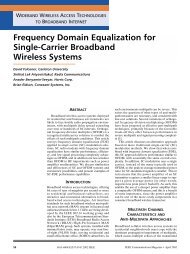Image Reconstruction for 3D Lung Imaging - Department of Systems ...
Image Reconstruction for 3D Lung Imaging - Department of Systems ...
Image Reconstruction for 3D Lung Imaging - Department of Systems ...
You also want an ePaper? Increase the reach of your titles
YUMPU automatically turns print PDFs into web optimized ePapers that Google loves.
also showed an increased Radial PE due to the contrast being pushed toward the tank<br />
centre <strong>for</strong> phantoms located in the end sections. This effect was less noticeable with the<br />
Planar EP configuration. Both the Planar and Planar-Offset EP configurations show little<br />
degradation due to electrode plane separation errors <strong>of</strong> up 20% (6cm on the 28cm tall tank).<br />
The Planar-Offset is slightly more robust than the Planar EP configuration in this regard.<br />
6.3.5 2D Limitations<br />
In addition to the seven <strong>3D</strong> EP configurations additional reconstructions were per<strong>for</strong>med<br />
using the same <strong>3D</strong> meshes but with the 16 electrodes arranged in a single plane at a height<br />
<strong>of</strong> 14cm. The plots <strong>of</strong> figure 6.11 were generated similarly to those <strong>of</strong> section 6.2.3: 28<br />
data frames from the r/2 phantom moving through 28 vertical locations. Figure 6.11(c)<br />
validates the obvious insight that vertical position cannot be resolved using a single plane <strong>of</strong><br />
electrodes. Regardless <strong>of</strong> actual phantom height, the 2D arrangement always reconstructs<br />
an image that is located in the plane <strong>of</strong> the electrodes. As the small target moves farther<br />
away from the electrode plane the resolution, figure 6.11(a), and the image magnitude,<br />
figure 6.11(d), both decrease while the the radial error, figure 6.11(b), increases.<br />
Phantom Height (cm)<br />
Phantom Height (cm)<br />
25<br />
20<br />
15<br />
10<br />
5<br />
25<br />
20<br />
15<br />
10<br />
5<br />
Electrode Plane<br />
0<br />
0.42 0.43 0.44 0.45 0.46 0.47 0.48 0.49 0.5 0.51 0.52<br />
Resolution (BR)<br />
Phantom Height<br />
<strong>Image</strong> Height<br />
(a) Resolution<br />
5 10 15 20 25<br />
<strong>Image</strong> Height (cm)<br />
(c) Contrast<br />
Electrode plane<br />
Phantom Height (cm)<br />
Phantom Height (cm)<br />
25<br />
20<br />
15<br />
10<br />
5<br />
25<br />
20<br />
15<br />
10<br />
5<br />
Electrode Plane<br />
-2.5 -2 -1.5 -1 -0.5 0 0.5 1 1.5<br />
Radial Error (%)<br />
(b) Radial Error<br />
Electrode Plane<br />
0.3 0.4 0.5 0.6 0.7 0.8 0.9 1<br />
<strong>Image</strong> Magnitude, Normalized to max=1<br />
(d) <strong>Image</strong> Magnitude (Normalized)<br />
Figure 6.11: Per<strong>for</strong>mance measures vs Phantom Height <strong>for</strong> noise free reconstructions with<br />
single layer <strong>of</strong> 16 electrodes <strong>for</strong> the small target moving through 28 vertical positions at r/2.<br />
6.3.6 Summary<br />
A qualitative summary <strong>of</strong> the significant discriminators is presented in table 6.3. Five <strong>of</strong><br />
the configurations show poor per<strong>for</strong>mance in one or more <strong>of</strong> the discriminators while the<br />
91





